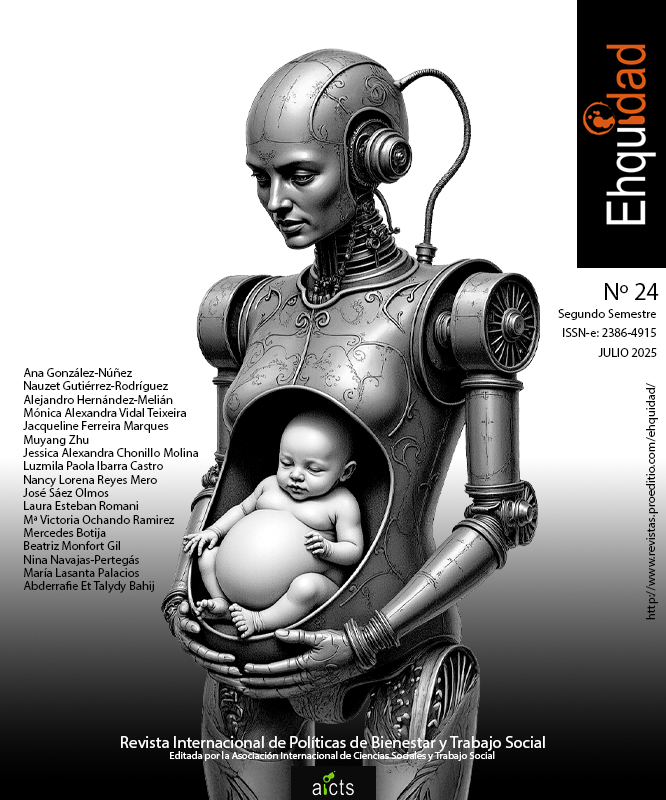Perception and satisfaction of Day Centre users: contributions to the analysis of its importance and functioning from the user's point of view
DOI:
https://doi.org/10.15257/ehquidad.2025.0013Keywords:
Day Care Centre, Specialised day care centre, Satisfaction with services providedAbstract
This descriptive study used a quantitative methodology to analyse the perception and satisfaction of users of Day Centres (DC) in relation to the services provided, namely: the programmes and services developed; the provision of services; the quality of care staff; the relationships established between those involved (users and staff) and the environmental organisation of the DC. Thirty-nine elderly people from five rural DCs in central Portugal participated in the study. Data were collected using a socio-demographic characterisation questionnaire and the CD assessment protocol for the elderly (PACD-II, adapted by Teixeira, Martin and Almeida, 2012, original version: Teixeira and Martin, 2008). The majority of the sample were women, aged 80-89 years, widowed, with little or no schooling, with a previous occupation related to agricultural or similar activities, living with their child(ren) and receiving a retirement pension. We conclude that the high level of use of the centre by older people demonstrates a real need or satisfaction in using the service, and that their entry into the CD is often due to difficulties related to dependency and/or health and problems of loneliness. In terms of social valuation, it can be concluded that the relationship that the user establishes with the staff is relevant to them. In terms of environmental valuation, the majority value the CD as an attractive and pleasant place, both structurally and environmentally. In general, and in line with the literature (Moriah et al., 2017), the users of the study expressed satisfaction with the CD, specifically with the services provided in the areas of health, rehabilitation, socio-cultural animation, counselling and basic services. It was also found that a large number of users were able to identify basic and entertainment services as well as health services (mainly preventive). When it comes to identifying the counselling and rehabilitation services offered, these are either non-existent or residual. According to the authors Conrad, Hanrahan and Hughes (1990), it is plausible that the variety of centres can be classified on the basis of the commonalities observed between them, so that specialisation allows for more efficient and productive treatment of the user (Conrad et al., 1993). It is considered essential that users participate in the decision on the specialisation and suitability of the day centre to their needs and wishes, without falling into an exaggerated specialisation that could be detrimental to one of its functions, the social function.
Downloads
References
Alteras, T. (2007). Adult Day Health Care Services: Serving the Chronic Health Needs of Frail Elderly Through Cost-Effective Non-Institutional Care. Health Management Associates. http://www.caads.org
Arrazola, F.J., Méndez, A.U., Lezaun, J.J. (2003). Centros de Día: Atención e Intervencion Integral para Personas e Mayores Dependientes e com Deterioro Cognitivo. Fundación Matía Gizartekintza - Departamento de Servicios Sociales
Artaso I., B.; Sarriés, A. G., Martínez, A. R. (2001). Características de la Población Atendida en un Centro de Día Psicogeriátrico en Navarra. Anales de Psiquiatría, 4 (17), pp.137-142. https://dialnet.unirioja.es/servlet/extaut?codigo=592302
Benet, A. S. (2002). La Dinamización Sociocultural en los Centros de Día para Mayores. Nuevas Perspectivas en el Trabajo Socioeducativo com Personas Mayores. Educación social- Revista d'intervenció sòcioeducativa, 22, pp. 97-110. https://raco.cat/index.php/EducacioSocial/article/view/165415
Benet, A. S. (2003). Los Centros de Día para Personas Mayores. Edicions de la Universitat
Benet, A. S. & Llanes, J.M. (2002). Nivel de Salud y Autonomía en los Centros de Día para Mayores. Revista Multidisciplinar de Gerontologia, 1 (12), pp. 5-12. http://hdl.handle.net/10459.1/31357
Bonfim, C.J., Teles, M.A., Saraiva, M.E. (1996). Centro de Dia -Condições de localização, instalação e funcionamento. Direcção Geral de Acção Social
Brown, E.L.; Friedemann, M.L., Mauro, A.C. (2012). Use of Adult Day Care Service Centers in an Ethnically Diverse Sample of Older Adults. Journal of Applied Gerontology, 33(2), pp. 189-206. https://doi.org/10.1177/0733464812460431
Conrad, K.J., Hanrahan, P., Hughes, S.L. (1990). Survey of Adult Day Care in the U.S.: National and Regional Findings. Research on Aging, 12 (1), pp. 36-57. https://doi.org/10.1177/0164027590121002
Conrad, K.J., Guttman, R. (1991). Characteristics of Alzheimer's versus Non-Alzheimer's Adult Day Care Centers. Journal of Research on Aging,13 (1), pp.96-116. https://doi.org/10.1177/0164027591131005
Conrad, K.J., Hughes S.L, Hanrahan P. & Wang S. (1993). Classification of Adult Day Care: a cluster analysis of services and activities. Journal of Gerontology: Social Sciences, 3 (48), pp. 112-122. https://pubmed.ncbi.nlm.nih.gov/8482827/
Conrad, K. J., & Buelow, J. R. (1990). Developing and testing program classification and function theories. New Directions for Program Evaluation, 1990(47), pp. 73–91. https://doi.org/10.1002/EV.1556
Dabelko-Schoeny, H., Balaswamy, S. (2000). Use of Adult Day Services and Home Health Care Services by Older Adults: A Comparative Analysis. Home Health Care Services Quarterly, 18 (3), pp. 65-79. https://doi.org/10.1300/j027v18n03_04
Dabelko-Schoeny, H., King, S. (2010). In Their Own Words: Participants' Perceptions of the Impact of Adult Day Services. Journal of Gerontological Social Work, 53 (2), pp.176-192. https://doi.org/10.1080/01634370903475936
DePalma, J.A. (2003). Positive outcomes and Adult Day Care. Home, Health, Care, Management & Practice, 15 (4), pp. 342-343. https://doi.org/10.1177/1084822303015004012
Du Preez, J., Millsteed, J., Marquis, R., & Richmond, J. (2018). The Role of Adult Day Services in Supporting the Occupational Participation of People with Dementia and Their Carers: An Integrative Review. Healthcare (Basel, Switzerland), 6(2). https://doi.org/10.3390/healthcare6020043
Ferreira, C., Monteiro, N., Warnes, A., Willians, A. & Friedrich, K. (2008). Estudo de avaliação das necessidades dos seniores em Portugal. – Relatório Final. Centro de Estudos e Desenvolvimento Regional e Urbano e Boston ConsultingGroup. Fundação Aga Khan. https://the.akdn/publications/2008_portugal_estudo%20seniores.pdf
Franciulli, S. E., Ricci, N. A.; Lemos, N. D., Cordeiro, R. C. & Gazzola, J. M. (2007). A modalidade de assistência Centro-Dia Geriátrico: efeitos funcionais em seis meses de acompanhamento multiprofissional. Ciência & Saúde Coletiva,12 (2), pp.373-380. https://doi.org/10.1590/S1413-81232007000200013
Gaugler, J.E., Zarit, S.H. (2001). The Effectiveness of Adult day Services for Disabled Older People. Journal of Aging & Social Policy, 2(12), pp. 23-47. https://doi.org/10.1300/J031v12n02_03
Henry, R.S., Cox, N.J., Reifler, B.V., Asbury, C. (2000). Adult Day Centers. In Robert Wood Johnson Foundation Antology: To Improve Health and Health Care, Chapter 5. https://oxfordre.com/socialwork/view/10.1093/acrefore/9780199975839.001.0001/acrefore-9780199975839-e-6?rskey=eKBLzO&result=1&q=Adult%20Day%20Care
Instituto da Segurança Social, ISSS (2000). Carta Social - Rede de Serviços e Equipamentos – Relatório 2000. www.gep.msess.gov.pt
Lecovich, E.R., Biderman, A. (2011). Attendance in adult day care centers and its relation to lonelinesss among frail older adults. Cambridge University Press.24 (3), pp.439-448. https://doi.org/10.1017/S1041610211001840
Leitner, M. J., Leitner, S. F. (1995), Senior day care centers. Activities Adaptation & Aging.7(5), pp.73-86. https://doi.org/10.1300/J016v07n03_06
Leturia, F., Yanguas, J. (1999). Intervención en ámbitos residenciales. In M. Izal & Montorio (Eds.), Gerontología conductual. Editorial Síntesis.
Logsdon, R. G., Pike, K. C., Korte, L., & Goehring, C. (2016). Memory Care and Wellness Services: Efficacy of Specialized Dementia Care in Adult Day Services. The Gerontologist, 56(2), pp. 318–325. https://doi.org/10.1093/geront/gnu012
Manchola, E. A. (2000). Recursos sociosanitarios - el Centro de Dia (CD) Psicogeriátrico. Revista Multidisciplinar de Gerontologia, 10(2), pp.105-125
Martín, I., Gonçalves, D., Paúl, C. & Pinto, F. (2007). Políticas Sociais para a Terceira Idade. In As pessoas idosas - contexto social e intervenção educativa. Instituto Piaget - Colecção Horizontes Pedagógicos
Martín, I., Lopes, E. (2008). Políticas sociais gerontológicas. Rediteia, 41, pp. 44-46. https://www.eapn.pt/centro-de-documentacao/rediteia-41
Martínez, M.V., Suárez, D.P., Iglesias, B.C. & Ponte, J.C. (2003). Análisis Estratégico de los Centros y Programas de Estancia Diurna para Personas Mayores Dependientes en la Comunidad Autónoma de Galicia. Idades - Asociación para la Investigación de la Discapacidad, la Dependencia y el Envejecimento
Mature Market Institute (MMI). (2010). The MetLife National Study of Adult Day Services – Providing support to Individuals and their Family Caregivers. https://www.nadsa.org/wp-content/uploads/2018/08/Metlife_ADS_Study.pdf
Moriah, E., Peter, D., Ariell, L., & Michael, W. (2017) Adult Day Center Programs and Their Associated Outcomes on Clients, Caregivers, and the Health System: A Scoping Review, The Gerontologist, Volume 57 (6), pp. 85–94. https://doi.org/10.1093/geront/gnw165
Mossello, E., Baccini, M., Caramelli, F., Biagini, C. A., Cester, A., De Vreese, L. P., Darvo, G., Vampini, C., Gotti, M., Fabbo, A., Marengoni, A., Cavallini, M. C., Gori, G., Chattat, R., Marini, M., Ceron, D., Lanzoni, A., Pizziolo, P., Mati, A. & Zilli, I. (2023). Italian guidance on Dementia Day Care Centres: A position paper. Aging clinical and experimental research, 35(4), 729–744. https://doi.org/10.1007/s40520-023-02356-4
Mossello, E., Caleri, V., Razzi, E., Di Bari, M., Cantini, C., Tonon, E., Lopilato, E., Marini, M., Simoni, D., Cavallini, M. C., Marchionni, N., Biagini, C. A., & Masotti, G. (2008). Day Care for older dementia patients: favorable effects on behavioral and psychological symptoms and caregiver stress. International journal of geriatric psychiatry, 23(10), pp.1066–1072. https://doi.org/10.1002/gps.2034
Pulleiro, C., Guzman, P., Rodriguez, G., Pérez, X., Rio, C. & Lezáun, J. (2007). Modelo de Centro de Día para la atención a personas con enfermedad de Alzheimer. Colección Documentos Serie Documentos Técnicos. Pamplona. Instituto de Mayores y Servicios Sociales (IMSERSO).
Quaresma, M.L. (1996). Cuidados Familiares às Pessoas muito idosas. Lisboa. Direcção Geral da Acção Social - Núcleo de Documentação Técnica e Divulgação. https://www.segsocial.pt/documents/10152/13328/Cuidados_fam_pes_muito_idosas/d6049f14-79ed-4501-97c3-b7400509aaad/d6049f14-79ed-4501-97c3-b7400509aaad
Rodriguez, T.M. (2001). Reorientando los Recursos de Atención a las Personas Mayores Hacia las Necesidades Derivadas de la Dependencia: de las Estancias Diurnas a los Centros de Día. Intervención Psicosocial, 3 (10), pp. 389-394. https://www.redalyc.org/pdf/1798/179818268009.pdf
Salgado, A. A., Montalvo, J. G. (1999). Centro de Dia para Personas Mayores - un esquema prático sobre su funcionamento. Revista Española de Geriatria y Gerontología, (34), pp. 298-305
Sanders, S., Sanders, J., Kintzle, S. & Osterhaus, J. K. (2007). Adult Day Services in Iowa – Strenghening a Critical Home and Community – Based Service. University of Iowa: School of Social Work.
Samuelsson, L., Malmberg, B., Hansson, J-H. (1998). Daycare for elderly people in Sweden: a national survey”. Scand J Soc Welfare ß Blackwell,7, pp.310-319. https://doi 10.1111/j.1468-2397. 1998.tb00251.x
Schmitt, E.M., Sands, L.P., Weiss, S., Dowling, G., Covinsky, K. (2010). Adult Day Health Center Participation and Health-Related Quality of Life. The Gerontologist, 50(4), pp. 531–540. https://doi.org/10.1093/geront/gnp172
SERDI (Serviço de Reabilitação e Protecção aos Diminuídos e Idosos) (1976). Centros de Dia. Execução de Equipa Técnica do SERDI. Conselho Técnico criado por despacho do secretário de Estado da Segurança Social de 29/12/75
Stern, A.L., Caro, F.G. (2004). Consumer Perspectives on Quality in Adult Day Care. Gerontology.InstitutePublications4. https://scholarworks.umb.edu/gerontologyinstitute_pubs/4
Svidén, G.A., Tham, K., Borell, L. (2004), Elderly participants of social and rehabilitative day centres. Scand Journal Caring Science, 18, pp. 402-409. https://doi.org/10.1111/j.1471-6712.2004.00297.x
Tajes, J.G. (2003). Centros de Dia para enfermos de Alzheimer. Cuadernos de Geriatria,11, pp. 9-20. Sociedade Aragonesa de Geriatria y Gerontologia
Tretteteig, S., Vatne, S. & Rokstad, A.M.M. (2017). The influence of day care centres designed for people with dementia on family caregivers – a qualitative study. BMC Geriatr 17, 5, pp. 1-11. https://doi.org/10.1186/s12877-016-0403-2
Trinidad, D. (1996). Programas de Salud Física - Centro de Día para Personas Mayores Dependientes. Madrid: Instituto Nacional de Servicios Sociales - Ministerio de Trabajo y Assuntos Sociales.
Wacker, R., Roberto, A. (2008). Community resources for older Adults - Programs and services in a Era of Change (2nd edition). Sage Publications
Weissert, W. G. (1977). Adult Day Care Programs in the United States: Current Research Projects and a Survey of 10 Centers. Public Health Reports,149(92), pp. 49-56. https://www.ncbi.nlm.nih.gov/pmc/articles/PMC1431964/
Weissert, W. G., Elston J.M., Bolda E.J., Cready C.M., Zelman W.N., Sloane P.D., Kalsbeek W.D., Mutran E., Rice T.H. & Koch G.G. (1989). Models of adult day care: Findings from a national survey. Gerontologist, 29 (5), pp. 640-649. https://doi.org/10.1093/geront/29.5.640
Woodhead, L., Zarit, S. H., Braungart, E. R., Rovine, M. J. & Femia, E. E. (2005). Behavioral and psychological symptoms of dementia: The effects of physical activity at adult day service centers. American Journal of Alzheimer’s Disease and Other Dementias, 20(3), pp.171-179. https://doi.org/10.1177/153331750502000314












